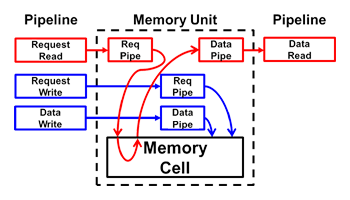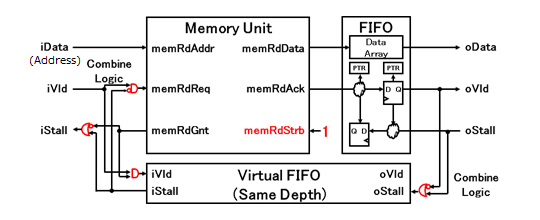| Latency(CLK) | 0 |
module wrMem(
iAdData, iAdVld, iAdStall,
iDtData, iDtVld, iDtStall,
memAddr, memReq, memGnt,
memData, memStrb, memAck,
reset, clk);
input [31:0] iAdData; // Address
input iAdVld;
output iAdStall;
input [31:0] iDtData; // Write Data
input iDtVld;
output iDtStall;
output [31:0] memAddr;
output memReq;
input memGnt;
output [31:0] memData;
output memStrb;
input memAck;
input reset;
input clk;
wire adVld;
wire dtVld, dtStall;
wire vaVld, vaStall;
wire vdVld, vdStall;
fifo adFifo ( // Address FIFO
.iData (iAdData),
.iVld (iAdVld),
.iStall (iAdStall),
.oData (memAddr),
.oVld (adVld),
.oStall (!memAdGnt | !vaVld | vdStall),
.reset (reset),
.clk (clk)
);
fifo dtFifo ( // Data FIFO
.iData (iDtData),
.iVld (iDtVld & !vaStall),
.iStall (dtStall),
.oData (memData),
.oVld (dtVld),
.oStall (!memDtAck | vdStall),
.reset (reset),
.clk (clk)
);
sig vaFifo ( // Virtual Address FIFO
.iVld (iDtVld & !dtStall),
.iStall (vaStall),
.oVld (vaVld),
.oStall (!memAdGnt | !adVld | vdStall),
.reset (reset),
.clk (clk)
);
sig vdFifo ( // Virtual Data FIFO
.iVld (memGnt & adVld & vaVld),
.iStall (vdStall),
.oVld (vdVld),
.oStall (!memAck | !dtVld),
.reset (reset),
.clk (clk)
);
assign iDtStall = dtStall | vaStall;
assign memReq = adVld & vaVld & !vdStall;
assign memStrb = dtVld & vdVld;
endmodule
|








